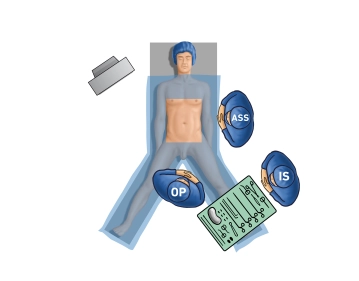The indication for laparoscopic liver resection depends less on the tumor entity but rather on the meaningful feasibility of the laparoscopic procedure. In turn, feasibility is governed primarily by the anatomical and functional technical parameters some of which also apply to conventional open liver resections.
Functional technical parameters
- Is R0 resection feasible?
- Will the resection leave a volume large enough for residual liver function?
- Number of previous (hepatic) operations (adhesions)?
- Reoperation after previous open liver surgery?
Anatomical parameters
- Tumor size?
- Number of lesions?
- Segmental location of the lesion(s)?
The so-called “laparoscopic segments II, III, IVB, V, and VI according to Couinaud” are particularly amenable to laparoscopic resection of benign and malignant tumors.
To date, laparoscopic resection of segments II and III can be considered state of the art in centers, since often the parenchymal bridge to segment IV is narrow and the hilar blood supply of the liver is easily accessible. Usually, Pringle’s maneuver is not required.
Because the limited view of the surgeon in laparoscopic liver resections markedly impacts on their feasibility, the line of resection should be linear and course in one plane only. Unlike in open surgery, during minimally invasive procedures it is hardly possible to alter the line of resection: For this reason, the resection strategy must be defined beforehand and may only be modified slightly following intraoperative ultrasonography.
Considering the aspects above, benign lesions such as adenomas, focal nodular, hyperplasia and symptomatic hemangiomas are good indications for laparoscopic liver resections. Malignant tumors primarily comprise liver metastases in colorectal cancer, but also hepatocellular carcinoma and metastases in breast cancer. In terms of technical feasibility this includes wedge resections, segment resections and left lateral resections.
Malignancies must meet the following conditions:
- Peripheral solitary tumor, maximum size 5cm or, in tumors >5cm, located in segment II/II
- Tumor located in segment II, III, IVb, V or VI
- No. of masses ≦3, all located in same lobe
- R0 resection feasible with one line of resection (left lateral resection, left/right hemihepatectomy)
- Large enough distance between lesion and central structures (inferior vena cava, hepatic veins, pedicle = branch from portal vein, hepatic artery and common hepatic duct)
- No previous hepatic surgery
- No concomitant procedures planned, e.g., colon resection, incisional hernia repair etc.
However, laparoscopic liver resection is indicated not just in tumors but is increasingly favored in harvesting hepatic grafts from living donors.


